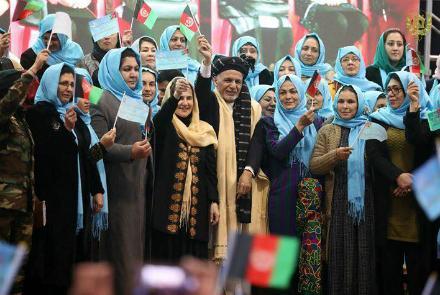Afghan women are right to fear that their rights could become a casualty of the ongoing peace talks. While Afghan women have been among the loudest voices for peace, they have scarcely featured in the talks so far, which have often been marked by all-male photo opportunities. There has been no serious mention of women’s rights either. The USA’s Special Envoy, Zalmay Khalilzad, recently said that the concerns of Afghan women and other human rights issues will only be addressed when an intra-Afghan dialogue takes place.
Under the Taliban’s rule, women were not allowed to leave their homes freely, let alone gain an education or work. Today, Afghan women are lawyers and judges, nurses and doctors, athletes and journalists, artists and activists, politicians and business owners. Nearly a third of parliament and the civil service is comprised of women. There are women in the police and the military. There is a dedicated Ministry of Women’s Affairs, with a presence in each province. And there is an independent Human Rights Commission, led by a renowned woman human rights defender.
There are four ministers who are women, several women who are deputy ministers, and five women who are ambassadors. Afghan women were involved in the post-2001 Bonn conference process that laid the ground for a new future for the country, and the Vice Chair of the Interim Administration was a woman. Afghan women were part of the Emergency and Constitutional Loya Jirga. Afghan women are also leaders in the development of their communities under the Afghan Solidarity Program, Community Development Council, and now the Citizen Charter.
These gains did not come easily. Afghan women led the fight for constitutional advances, such as Articles 83 and 84 of the Afghan Constitution, which ensure women’s participation in parliament, including at least two women from each province. The landmark law on the Elimination of Violence against Women, passed in 2009, was the culmination of a decades-long and hard-fought struggle.
The Taliban, meanwhile, have shown few signs of change. They have said that they now have a more lenient attitude when it comes to women’s education, but the way they have operated in the areas they control does not inspire any confidence. Indeed, there we continue to see many of the horrors that earned them notoriety when they were in power from 1996 to 2001. Just three years ago, for example, the Taliban publicly executed two women in the northern province of Jawzjan. According to the New York Times, Rabia, a 22-year-old woman, was shot dead after being accused of adultery. In 2015, in the Taliban-controlled province of Ghor, a woman was stoned to death. The Taliban has threatened women, human rights defenders, and murdered school teachers who are women. Last year, ten percent of all civilian casualties – the highest on record – were women.
There are, of course, still huge challenges that Afghan women face. The Elimination of the Violence against Women law is frequently ignored by the authorities, who allow for “mediation” to take the place of prosecutions, breeding a culture of impunity. Domestic violence remains a serious problem, as do child marriages. Women face harassment and discrimination when it comes to their rights to health and education. These abuses are not on the scale of those perpetrated under the Taliban, but they demonstrate the need to persist with the fight for women’s rights.
Afghanistan also has international obligations when it comes to the protection and promotion of women’s rights. These should be at the heart of any peace talks that take place. The UN Security Council’s Resolution 1325 clearly affirms the role of women in “the prevention and resolution of conflicts, peace negotiations, peacekeeping, humanitarian response and in post-conflict reconstruction and stresses the importance of their equal participation and full involvement in all efforts for the maintenance and promotion of peace and security”.
Not only should women be at the table during peace talks, such as at the forthcoming consultative Jirga on the peace process that the government has announced for late March, but no agreement that results from them should limit their rights in any way. Since 2001, a key justification for the international community’s presence in Afghanistan was to improve women's rights. It would be a great tragedy if those same concerns were now abandoned when there is a chance at peace.
Zaman Sultani is a South Asia Researcher at Amnesty International.

